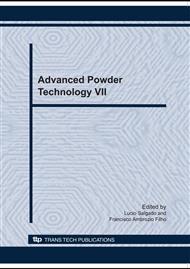p.448
p.454
p.463
p.468
p.477
p.483
p.489
p.495
p.503
A Novel Method for Obtaining Polycrystalline Diamond Cutters
Abstract:
The present work comprises a study about the possibility of obtaining polycrystalline diamond cutters through a novel method of sintering both layers at the same time. This possibility was tested through the sintering of a diamond layer over a hard metal (WC+15wt%Co) support under conditions of 5.0 and 6.5 GPa of pressure and 1400 to 1600º C of temperature. The sintering conditions were imposed in two ways: directly, or with pre-sintering. The samples were tested by measuring microhardness, wear resistance, densification, and SEM. The results of the tests have shown the possibility of obtaining good quality inserts by sintering both layers of compacted powder.
Info:
Periodical:
Pages:
477-482
Citation:
Online since:
October 2010
Price:
Сopyright:
© 2010 Trans Tech Publications Ltd. All Rights Reserved
Share:
Citation:


